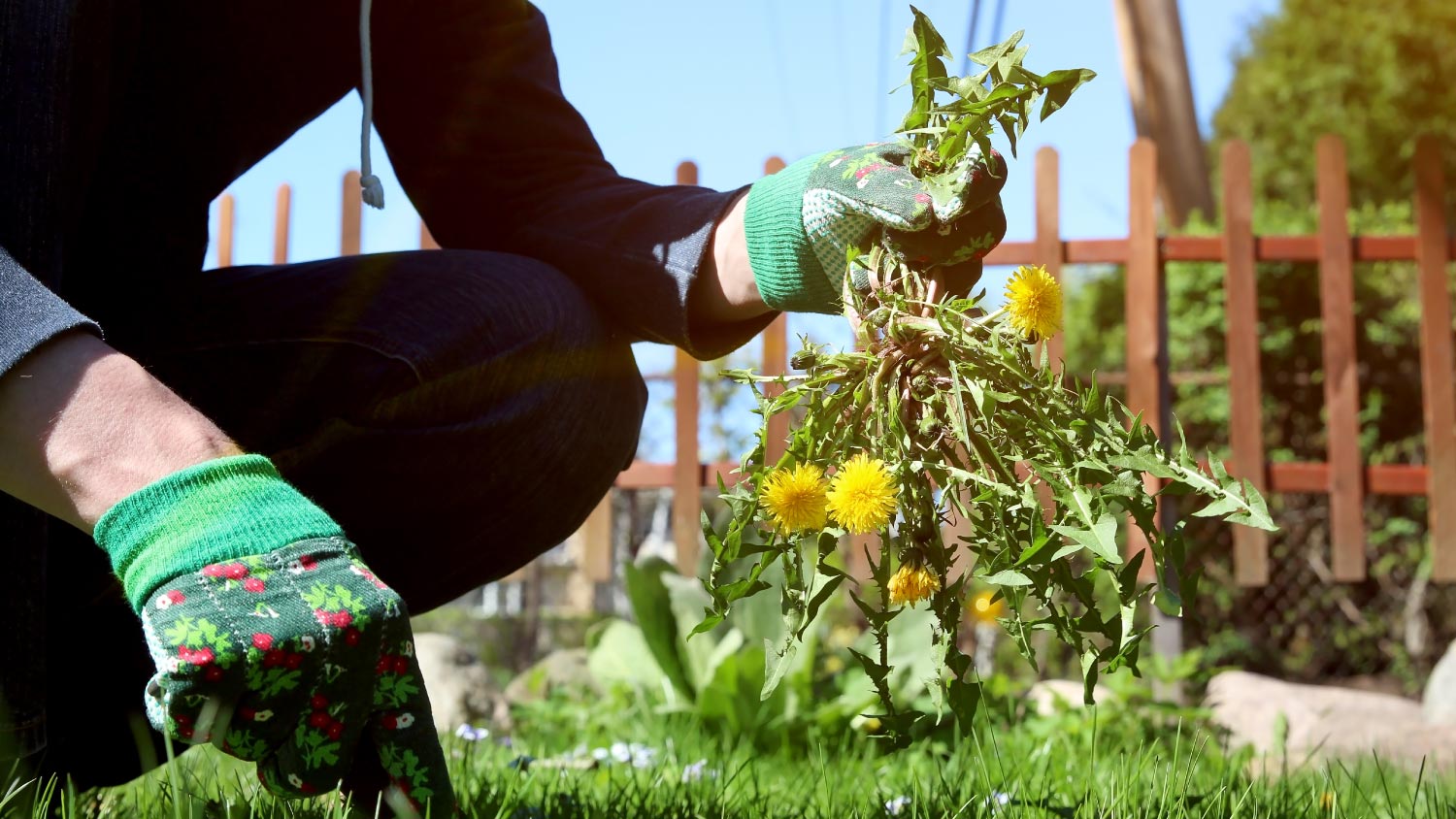
Leveling your yard can help with drainage and prevent damage to your home. Learn the cost to level a yard and what factors can affect the price.
Don’t just wish for a dandelion-free yard—make it happen


Remember holding up those little white globes and making a wish while you try to blow all the seeds away? Turns out, this sweet childhood game helps the wind-dispersed weed survive. But if your wish these days is to learn how to get rid of dandelions, you’re not alone.
A hardy plant, dandelions can grow just about anywhere, including your lovely lawn. The good news is that you have options for removing dandelions, and there are things you can do to prevent them from returning too.
According to the U.S. Department of Health and Human Services, dandelion (Taraxacum officinale) is a broadleaf perennial herb native to Europe but now commonly found throughout all 50 states in the U.S. This includes the temperate regions of the Northern Hemisphere, including Mexico and Canada.
Dandelions are hardy weeds that tolerate a variety of soil types and conditions, including very poor soil. They are also very disease- and pest-resistant.
If you’re the unlucky recipient of these cute-but-annoying weeds, it’s thanks to the wind. The seed heads have a parachute-like quality that allows them to be dispersed and travel via the wind. This means it’s very common to have dandelions in your yard—and you’re definitely not the only one on your block searching for ways to get rid of them either.
A large amount of dandelions recurring in a specific part of your yard is an indication your soil may be lacking nutrients or that your lawn isn’t healthy.
If you find that DIY solutions aren’t working, contact a local landscaping company for help removing dandelions from your yard for good.
Removing weeds by hand is a fairly cost-effective DIY. Even if you pay for a broadleaf herbicide ($10), gloves ($5), and a weeding tool ($7), your total cost to remove weeds yourself will likely be under $25.
The cost of weed removal by a professional is generally between $35 and $125, but preventing weeds does require ongoing lawn maintenance. Expect to pay $100 to $250 for seasonal maintenance, plus $50 to $200 for monthly upkeep.

The ideal time to remove dandelion weeds from lawn or garden beds is when they are still small plants and have not yet formed yellow flower heads, which is the early spring for most climates.
Dandelions will typically emerge when soil temperatures reach 50 degrees Fahrenheit. It is critical to remove any dandelions before the yellow flowers turn into fluffy white seed heads. The seeds spread quickly by the wind and will germinate again in your yard.
If using a spot dandelion killer, you may find it most effective in the fall. This is because the dandelion leaves are not growing as much, and the weed killer will target the root. This helps to kill the plant permanently. You can also use a homemade weed killer using vinegar and dish soap.
Although you want to get rid of dandelions before the seed heads form, simply cutting them is not enough. The most effective way to get rid of dandelions is to remove them by hand. The tricky part is that dandelions notoriously have long tap roots, which is why simply cutting them with a mower doesn’t prevent them from growing back.
Pull the weeds by hand before they develop fluffy white seed heads.
Water your lawn enough to make sure the soil is damp.
Using a weeding tool, loosen the tap root of the dandelion.
Gently pull on the plant. It should come up easily, otherwise, keep loosening it with the tool.
You can add a dandelion killer in the hole to completely kill the root; be careful not to spray the surrounding lawn.
Fill the hole in with dirt and allow grass to grow over it.
If there is a larger bald patch, you can sow grass seeds over it as well.
Any herbicide applied to dandelions can also kill grass.
Try to treat dandelions when they are young plants.
For a more targeted application, create a spray collar with a can or plastic bottle that has had the top and bottom removed.
Place the collar around the individual dandelion weed.
Spray herbicide directly on the individual plant.
Once the plant looks withered, use the hand-removal method to loosen soil and pull each weed by hand.
Once dandelions mature, they’re more weed-killer-resistant.
Before spraying, injure individual plants by scuffing them with your foot a few times.
Spray each plant individually.
Once the plant begins to die, you can follow the hand-removal steps above.
If you have widespread dandelion weeds in your lawn and removing them by hand seems far too difficult, you can apply a broadleaf herbicide to your entire lawn. This may be in liquid form (applied via a hose-end sprayer) or it may be granular.
The United States Environmental Protection Agency (EPA) cautions homeowners that herbicides can be dangerous to pets and wildlife, specifically fish and invertebrates, as chemicals can leach into water streams and groundwater. Some herbicides will also damage landscaping plants.
According to the EPA, one of the ways to reduce impact on wildlife is to use these products sparingly. This means using them only when necessary and in targeted amounts. The EPA also suggests regularly inspecting containers that hold herbicides for leaks or cracks to be sure they aren’t leaching chemicals.
Never rinse containers somewhere that can go into groundwater, and dispose of unused chemicals or containers properly at a site that accepts chemical waste.
Follow the manufacturer's instructions for use of the specific product.
Always wear waterproof gloves, mask, and eye protection.
Make sure pets and kids aren’t in the area.
Don’t apply when it’s windy.
Don’t apply to a dry or heat-stressed lawn.
Follow manufacturer’s instructions regarding rainfall. Some require you to wait up to two days following heavy rain. It’s also a good idea to not apply right before a rain as the chemicals will just leach into the ground.
A healthy lawn is the best preventative against dandelions or other weed invasions, so once you’ve removed all those dandelions, pay attention to the overall health of your lawn.
Follow a basic lawn maintenance schedule to keep your grass growing strong. Additionally, try to remove any dandelions before the yellow flowers turn into white seed heads.
Keep your grass at least 3–4 inches long.
Water infrequently and deeply to encourage deep roots. Aim for 1 inch of water a week once established for 10–15 minutes. You will need to water more if it has been hot, less if it rains.
Fertilize your grass seasonally.
Some gardeners will use a pre-emergent herbicide to prevent weeds from germinating.
Although it is somewhat time-consuming to remove weeds by hand, it is fairly straightforward as well as cost-effective. For the handy homeowner with a weeder and a good pair of gloves, it’s something they can tackle on a saturday afternoon. However, the best way to control weeds is to maintain a healthy lawn.
Many homeowners consider hiring a local lawn care service well worth the investment. A lawn care professional will make sure your lawn is strong enough to crowd out pesky dandelions and other weeds, leaving you with more time to enjoy the grass.
From average costs to expert advice, get all the answers you need to get your job done.

Leveling your yard can help with drainage and prevent damage to your home. Learn the cost to level a yard and what factors can affect the price.

Ivy might look pretty, but you probably don’t want it in your garden. Learn how much it’ll cost to remove ivy by type, treatment method, and more.
.jpg?impolicy=leadImage)
Landscaping your yard adds curb appeal and expands your home’s living space into the outdoors. Learn how much landscaping costs for various projects.

It’s natural to judge, but which home aspects get the most criticism? From lawn care to messiness, find out what homeowners really judge the most.

If you need to get rid of a bush, here’s how to handle this project in a few simple steps. Follow our step-by-step instructions.

A perfectly level ground is crucial for a safe and enjoyable pool experience. Learn who to hire to level the ground and prepare your backyard oasis.